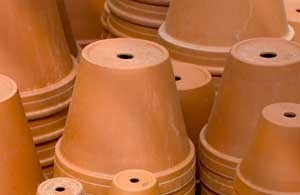
The roots of some plants prefer the wide open spaces of living in a large-sized pot. For other plants' roots, a tight, cozy pot where they can reach out and touch the walls feels more like home. No matter what their preference is, sooner or later just about every plant outgrows its pot. And even if it never does, it will probably need repotting anyway. So how do you know when it's time to repot your plant? Here's what to watch out for:
For the majority of houseplants, the best time to repot is in the spring and fall when growth is slow and the plant is either heading into dormancy or just waking up. This is the best time for plants to recover from disturbances in their environment. Spring blooming plants should be repotted in the fall, evergreens in the spring or fall, and spring flowering bulbs in the fall.
Never repot sick plants or plants that are just beginning to flower. For plants in extremely large or heavy containers, do not attempt to pot them without assistance. In most cases, they can be kept fresh by removing the top 2 or 3 inches of soil every few years and topdressing with new mix.
If your plant has outgrown its current pot, select a new pot that is only 1 or 2 inches wider and deeper than the original. If you want to control the plant's growth but need to repot it to amend the soil, prune the plant's roots and return it to its original pot. To do this, use a shears to trim away 1/4 to 1/3 of the roots. If the roots are tightly bound, trim 1/4 inch off of the bottom of the root ball in several places. After trimming the roots, prune the top growth back a bit to maintain a good balance between foliage and roots.
Prepare a new pot: Use small pieces of broken pottery or stoneware to cover the drainage holes. This will prevent the soil (and accompanying nutrients) from washing out every time you water. If the pot lacks drainage holes, either add some using a cordless drill with a ceramic bit (don't forget the safety glasses), or cover the bottom of the pot with an inch of horticultural grade charcoal or coarse gravel.
Remove the plant: Remove the plant from its pot and gently disturb the roots to loosen up the root ball. If necessary, carefully score an X in the bottom of the rootball with a sharp knife to loosen them.
Transplant: Fill the new pot with a well-drained potting mix so that when the plant is placed in the pot, the top of the rootball will rest within an inch of the rim. A good mix consists of equal parts peat moss, vermiculite or perlite, and sand.
Set the plant into the pot and gently fill in around the rootball with soil. As much as possible, avoid adding soil to the top of the pot. You don't want the rootball to end up deeper than originally planted. Tap the pot gently on a hard surface to encourage the potting mix to settle in around the plant and water the pot thoroughly until water runs freely through the drainage holes. Continue to add water and soil around the plant as needed, but do not tap the pot on a hard surface once you've watered it, or you'll only compact the soil. Do not resume fertilizing for several weeks.
Expect to repot most plants every two or three years. Extremely fast-growing plants may need to be repotted annually, whereas plants that prefer to be rootbound may only need repotting occasionally when soil conditions call for it. Seasonal container plants like annuals or vegetables generally do not need repotting during their single season.

About The Author: Ellen Brown is an environmental writer and photographer and the owner of Sustainable Media, an environmental media company that specializes in helping businesses and organizations promote eco-friendly products and services. Contact her on the web at http://www.sustainable-media.com
Add your voice! Click below to comment. ThriftyFun is powered by your wisdom!